Environmental Factors and Survey Research: An Article Analysis
VerifiedAdded on 2023/04/23
|21
|8858
|58
Homework Assignment
AI Summary
This assignment analyzes the research paper "Environmental Factors and Survey Research in Developing Countries: Evidence from Nigeria." The paper investigates how environmental factors, such as low literacy levels, language barriers, and respondent biases, impact survey research in Nigeria. The study used a quantitative method with a survey evaluation instrument (SEI) distributed to lecturers, researchers, and students. The findings highlight significant challenges, including misleading responses and the inability of respondents to answer questions accurately. The assignment reviews the paper's introduction, literature review, methodology, results, and conclusions, emphasizing the need to address these environmental factors to improve survey research quality and the reliability of research findings. The paper also discusses survey typologies, theoretical underpinnings from communication theories, and the implications of the findings for both theory and practice, offering recommendations for future research.
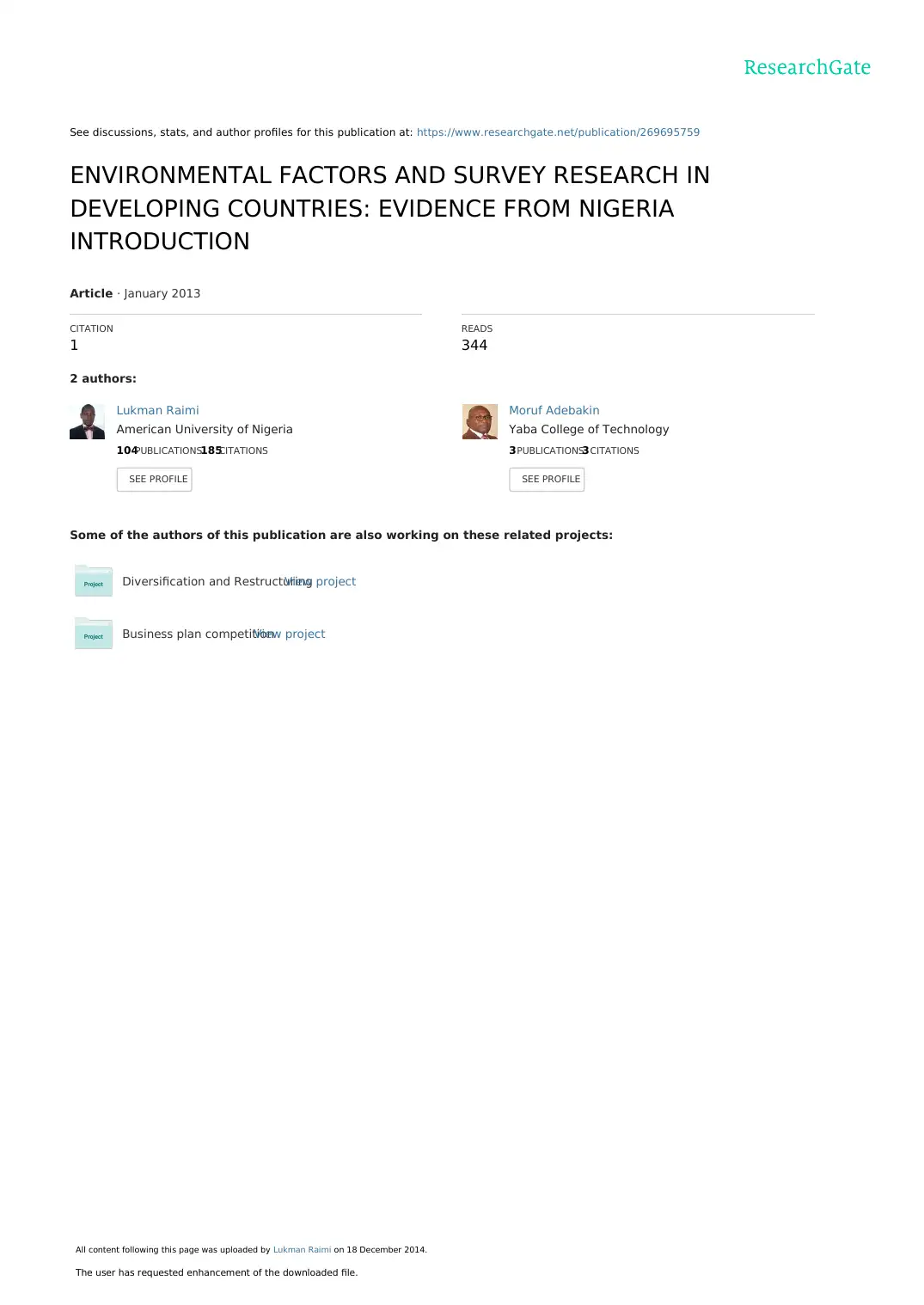
See discussions, stats, and author profiles for this publication at: https://www.researchgate.net/publication/269695759
ENVIRONMENTAL FACTORS AND SURVEY RESEARCH IN
DEVELOPING COUNTRIES: EVIDENCE FROM NIGERIA
INTRODUCTION
Article · January 2013
CITATION
1
READS
344
2 authors:
Some of the authors of this publication are also working on these related projects:
Diversification and RestructuringView project
Business plan competitionView project
Lukman Raimi
American University of Nigeria
104PUBLICATIONS185CITATIONS
SEE PROFILE
Moruf Adebakin
Yaba College of Technology
3 PUBLICATIONS3 CITATIONS
SEE PROFILE
All content following this page was uploaded by Lukman Raimi on 18 December 2014.
The user has requested enhancement of the downloaded file.
ENVIRONMENTAL FACTORS AND SURVEY RESEARCH IN
DEVELOPING COUNTRIES: EVIDENCE FROM NIGERIA
INTRODUCTION
Article · January 2013
CITATION
1
READS
344
2 authors:
Some of the authors of this publication are also working on these related projects:
Diversification and RestructuringView project
Business plan competitionView project
Lukman Raimi
American University of Nigeria
104PUBLICATIONS185CITATIONS
SEE PROFILE
Moruf Adebakin
Yaba College of Technology
3 PUBLICATIONS3 CITATIONS
SEE PROFILE
All content following this page was uploaded by Lukman Raimi on 18 December 2014.
The user has requested enhancement of the downloaded file.
Paraphrase This Document
Need a fresh take? Get an instant paraphrase of this document with our AI Paraphraser
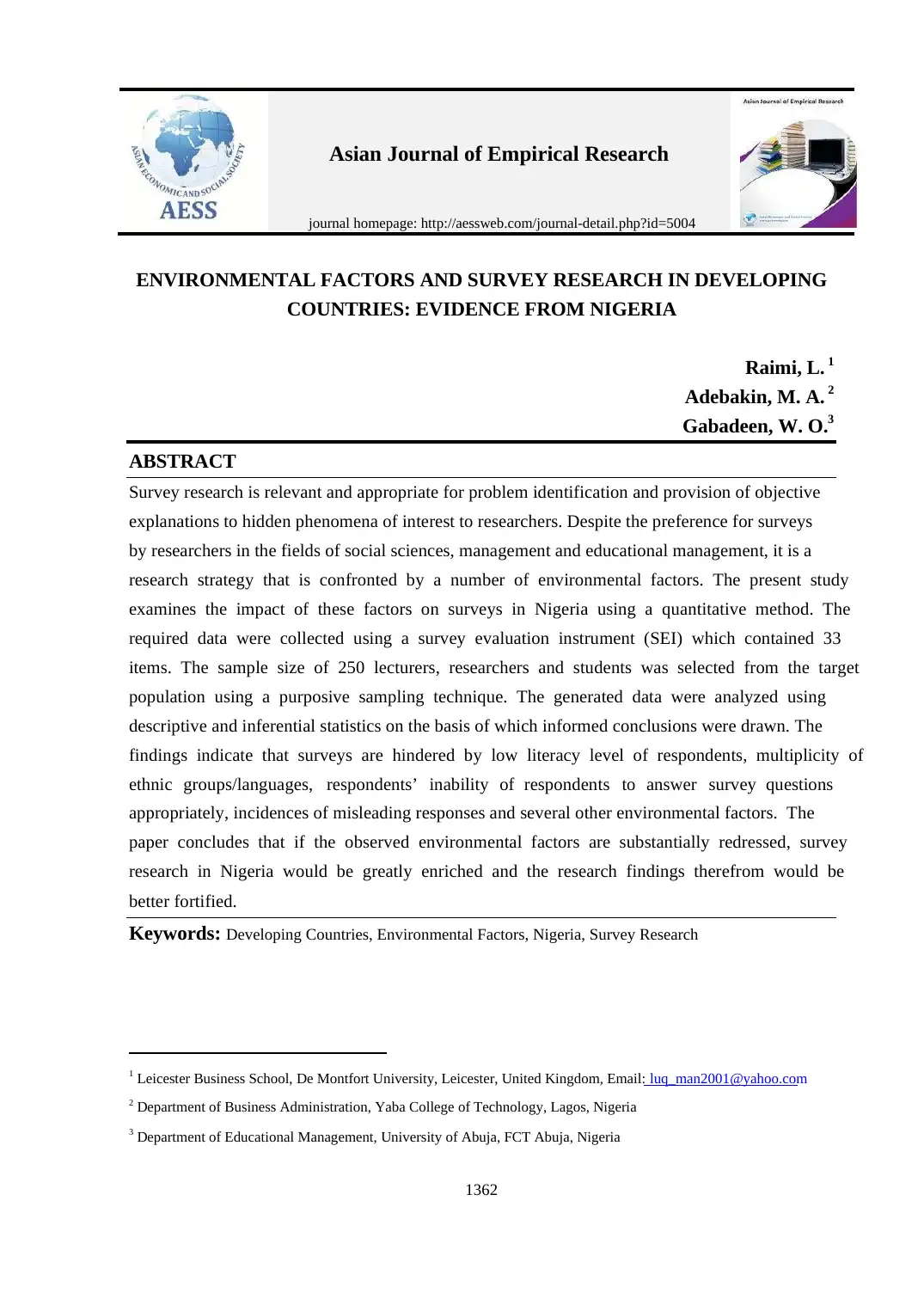
.
1362
ENVIRONMENTAL FACTORS AND SURVEY RESEARCH IN DEVELOPING
COUNTRIES: EVIDENCE FROM NIGERIA
Raimi, L. 1
Adebakin, M. A. 2
Gabadeen, W. O.3
ABSTRACT
Survey research is relevant and appropriate for problem identification and provision of objective
explanations to hidden phenomena of interest to researchers. Despite the preference for surveys
by researchers in the fields of social sciences, management and educational management, it is a
research strategy that is confronted by a number of environmental factors. The present study
examines the impact of these factors on surveys in Nigeria using a quantitative method. The
required data were collected using a survey evaluation instrument (SEI) which contained 33
items. The sample size of 250 lecturers, researchers and students was selected from the target
population using a purposive sampling technique. The generated data were analyzed using
descriptive and inferential statistics on the basis of which informed conclusions were drawn. The
findings indicate that surveys are hindered by low literacy level of respondents, multiplicity of
ethnic groups/languages, respondents’ inability of respondents to answer survey questions
appropriately, incidences of misleading responses and several other environmental factors. The
paper concludes that if the observed environmental factors are substantially redressed, survey
research in Nigeria would be greatly enriched and the research findings therefrom would be
better fortified.
Keywords: Developing Countries, Environmental Factors, Nigeria, Survey Research
1 Leicester Business School, De Montfort University, Leicester, United Kingdom, Email: luq_man2001@yahoo.com
2 Department of Business Administration, Yaba College of Technology, Lagos, Nigeria
3 Department of Educational Management, University of Abuja, FCT Abuja, Nigeria
Asian Journal of Empirical Research
journal homepage: http://aessweb.com/journal-detail.php?id=5004
1362
ENVIRONMENTAL FACTORS AND SURVEY RESEARCH IN DEVELOPING
COUNTRIES: EVIDENCE FROM NIGERIA
Raimi, L. 1
Adebakin, M. A. 2
Gabadeen, W. O.3
ABSTRACT
Survey research is relevant and appropriate for problem identification and provision of objective
explanations to hidden phenomena of interest to researchers. Despite the preference for surveys
by researchers in the fields of social sciences, management and educational management, it is a
research strategy that is confronted by a number of environmental factors. The present study
examines the impact of these factors on surveys in Nigeria using a quantitative method. The
required data were collected using a survey evaluation instrument (SEI) which contained 33
items. The sample size of 250 lecturers, researchers and students was selected from the target
population using a purposive sampling technique. The generated data were analyzed using
descriptive and inferential statistics on the basis of which informed conclusions were drawn. The
findings indicate that surveys are hindered by low literacy level of respondents, multiplicity of
ethnic groups/languages, respondents’ inability of respondents to answer survey questions
appropriately, incidences of misleading responses and several other environmental factors. The
paper concludes that if the observed environmental factors are substantially redressed, survey
research in Nigeria would be greatly enriched and the research findings therefrom would be
better fortified.
Keywords: Developing Countries, Environmental Factors, Nigeria, Survey Research
1 Leicester Business School, De Montfort University, Leicester, United Kingdom, Email: luq_man2001@yahoo.com
2 Department of Business Administration, Yaba College of Technology, Lagos, Nigeria
3 Department of Educational Management, University of Abuja, FCT Abuja, Nigeria
Asian Journal of Empirical Research
journal homepage: http://aessweb.com/journal-detail.php?id=5004
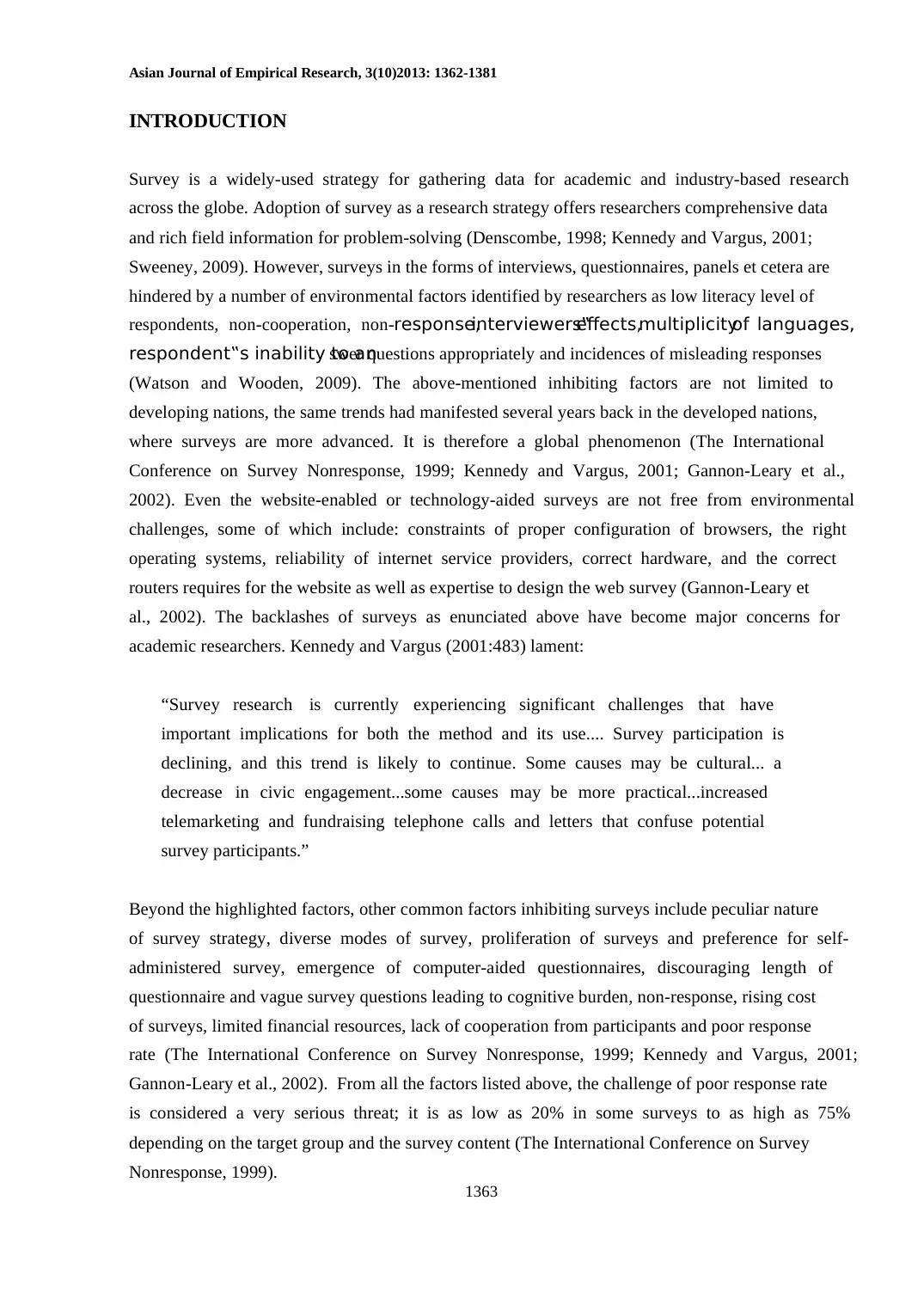
Asian Journal of Empirical Research, 3(10)2013: 1362-1381
1363
INTRODUCTION
Survey is a widely-used strategy for gathering data for academic and industry-based research
across the globe. Adoption of survey as a research strategy offers researchers comprehensive data
and rich field information for problem-solving (Denscombe, 1998; Kennedy and Vargus, 2001;
Sweeney, 2009). However, surveys in the forms of interviews, questionnaires, panels et cetera are
hindered by a number of environmental factors identified by researchers as low literacy level of
respondents, non-cooperation, non-response,interviewers‟effects,multiplicityof languages,
respondent‟s inability to answer questions appropriately and incidences of misleading responses
(Watson and Wooden, 2009). The above-mentioned inhibiting factors are not limited to
developing nations, the same trends had manifested several years back in the developed nations,
where surveys are more advanced. It is therefore a global phenomenon (The International
Conference on Survey Nonresponse, 1999; Kennedy and Vargus, 2001; Gannon-Leary et al.,
2002). Even the website-enabled or technology-aided surveys are not free from environmental
challenges, some of which include: constraints of proper configuration of browsers, the right
operating systems, reliability of internet service providers, correct hardware, and the correct
routers requires for the website as well as expertise to design the web survey (Gannon-Leary et
al., 2002). The backlashes of surveys as enunciated above have become major concerns for
academic researchers. Kennedy and Vargus (2001:483) lament:
“Survey research is currently experiencing significant challenges that have
important implications for both the method and its use.... Survey participation is
declining, and this trend is likely to continue. Some causes may be cultural... a
decrease in civic engagement...some causes may be more practical...increased
telemarketing and fundraising telephone calls and letters that confuse potential
survey participants.”
Beyond the highlighted factors, other common factors inhibiting surveys include peculiar nature
of survey strategy, diverse modes of survey, proliferation of surveys and preference for self-
administered survey, emergence of computer-aided questionnaires, discouraging length of
questionnaire and vague survey questions leading to cognitive burden, non-response, rising cost
of surveys, limited financial resources, lack of cooperation from participants and poor response
rate (The International Conference on Survey Nonresponse, 1999; Kennedy and Vargus, 2001;
Gannon-Leary et al., 2002). From all the factors listed above, the challenge of poor response rate
is considered a very serious threat; it is as low as 20% in some surveys to as high as 75%
depending on the target group and the survey content (The International Conference on Survey
Nonresponse, 1999).
1363
INTRODUCTION
Survey is a widely-used strategy for gathering data for academic and industry-based research
across the globe. Adoption of survey as a research strategy offers researchers comprehensive data
and rich field information for problem-solving (Denscombe, 1998; Kennedy and Vargus, 2001;
Sweeney, 2009). However, surveys in the forms of interviews, questionnaires, panels et cetera are
hindered by a number of environmental factors identified by researchers as low literacy level of
respondents, non-cooperation, non-response,interviewers‟effects,multiplicityof languages,
respondent‟s inability to answer questions appropriately and incidences of misleading responses
(Watson and Wooden, 2009). The above-mentioned inhibiting factors are not limited to
developing nations, the same trends had manifested several years back in the developed nations,
where surveys are more advanced. It is therefore a global phenomenon (The International
Conference on Survey Nonresponse, 1999; Kennedy and Vargus, 2001; Gannon-Leary et al.,
2002). Even the website-enabled or technology-aided surveys are not free from environmental
challenges, some of which include: constraints of proper configuration of browsers, the right
operating systems, reliability of internet service providers, correct hardware, and the correct
routers requires for the website as well as expertise to design the web survey (Gannon-Leary et
al., 2002). The backlashes of surveys as enunciated above have become major concerns for
academic researchers. Kennedy and Vargus (2001:483) lament:
“Survey research is currently experiencing significant challenges that have
important implications for both the method and its use.... Survey participation is
declining, and this trend is likely to continue. Some causes may be cultural... a
decrease in civic engagement...some causes may be more practical...increased
telemarketing and fundraising telephone calls and letters that confuse potential
survey participants.”
Beyond the highlighted factors, other common factors inhibiting surveys include peculiar nature
of survey strategy, diverse modes of survey, proliferation of surveys and preference for self-
administered survey, emergence of computer-aided questionnaires, discouraging length of
questionnaire and vague survey questions leading to cognitive burden, non-response, rising cost
of surveys, limited financial resources, lack of cooperation from participants and poor response
rate (The International Conference on Survey Nonresponse, 1999; Kennedy and Vargus, 2001;
Gannon-Leary et al., 2002). From all the factors listed above, the challenge of poor response rate
is considered a very serious threat; it is as low as 20% in some surveys to as high as 75%
depending on the target group and the survey content (The International Conference on Survey
Nonresponse, 1999).
⊘ This is a preview!⊘
Do you want full access?
Subscribe today to unlock all pages.

Trusted by 1+ million students worldwide
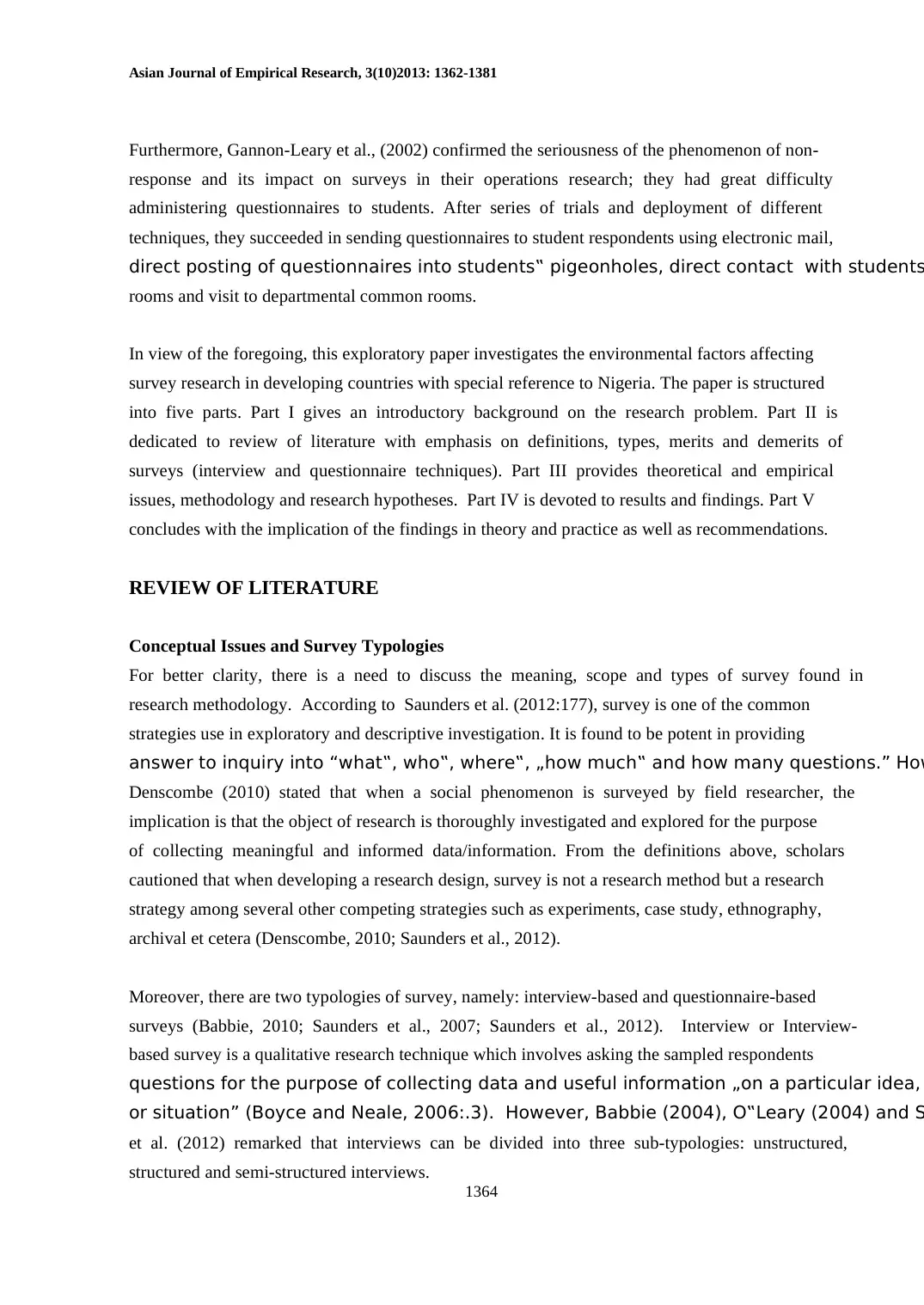
Asian Journal of Empirical Research, 3(10)2013: 1362-1381
1364
Furthermore, Gannon-Leary et al., (2002) confirmed the seriousness of the phenomenon of non-
response and its impact on surveys in their operations research; they had great difficulty
administering questionnaires to students. After series of trials and deployment of different
techniques, they succeeded in sending questionnaires to student respondents using electronic mail,
direct posting of questionnaires into students‟ pigeonholes, direct contact with students
rooms and visit to departmental common rooms.
In view of the foregoing, this exploratory paper investigates the environmental factors affecting
survey research in developing countries with special reference to Nigeria. The paper is structured
into five parts. Part I gives an introductory background on the research problem. Part II is
dedicated to review of literature with emphasis on definitions, types, merits and demerits of
surveys (interview and questionnaire techniques). Part III provides theoretical and empirical
issues, methodology and research hypotheses. Part IV is devoted to results and findings. Part V
concludes with the implication of the findings in theory and practice as well as recommendations.
REVIEW OF LITERATURE
Conceptual Issues and Survey Typologies
For better clarity, there is a need to discuss the meaning, scope and types of survey found in
research methodology. According to Saunders et al. (2012:177), survey is one of the common
strategies use in exploratory and descriptive investigation. It is found to be potent in providing
answer to inquiry into “what‟, who‟, where‟, „how much‟ and how many questions.” How
Denscombe (2010) stated that when a social phenomenon is surveyed by field researcher, the
implication is that the object of research is thoroughly investigated and explored for the purpose
of collecting meaningful and informed data/information. From the definitions above, scholars
cautioned that when developing a research design, survey is not a research method but a research
strategy among several other competing strategies such as experiments, case study, ethnography,
archival et cetera (Denscombe, 2010; Saunders et al., 2012).
Moreover, there are two typologies of survey, namely: interview-based and questionnaire-based
surveys (Babbie, 2010; Saunders et al., 2007; Saunders et al., 2012). Interview or Interview-
based survey is a qualitative research technique which involves asking the sampled respondents
questions for the purpose of collecting data and useful information „on a particular idea,
or situation” (Boyce and Neale, 2006:.3). However, Babbie (2004), O‟Leary (2004) and S
et al. (2012) remarked that interviews can be divided into three sub-typologies: unstructured,
structured and semi-structured interviews.
1364
Furthermore, Gannon-Leary et al., (2002) confirmed the seriousness of the phenomenon of non-
response and its impact on surveys in their operations research; they had great difficulty
administering questionnaires to students. After series of trials and deployment of different
techniques, they succeeded in sending questionnaires to student respondents using electronic mail,
direct posting of questionnaires into students‟ pigeonholes, direct contact with students
rooms and visit to departmental common rooms.
In view of the foregoing, this exploratory paper investigates the environmental factors affecting
survey research in developing countries with special reference to Nigeria. The paper is structured
into five parts. Part I gives an introductory background on the research problem. Part II is
dedicated to review of literature with emphasis on definitions, types, merits and demerits of
surveys (interview and questionnaire techniques). Part III provides theoretical and empirical
issues, methodology and research hypotheses. Part IV is devoted to results and findings. Part V
concludes with the implication of the findings in theory and practice as well as recommendations.
REVIEW OF LITERATURE
Conceptual Issues and Survey Typologies
For better clarity, there is a need to discuss the meaning, scope and types of survey found in
research methodology. According to Saunders et al. (2012:177), survey is one of the common
strategies use in exploratory and descriptive investigation. It is found to be potent in providing
answer to inquiry into “what‟, who‟, where‟, „how much‟ and how many questions.” How
Denscombe (2010) stated that when a social phenomenon is surveyed by field researcher, the
implication is that the object of research is thoroughly investigated and explored for the purpose
of collecting meaningful and informed data/information. From the definitions above, scholars
cautioned that when developing a research design, survey is not a research method but a research
strategy among several other competing strategies such as experiments, case study, ethnography,
archival et cetera (Denscombe, 2010; Saunders et al., 2012).
Moreover, there are two typologies of survey, namely: interview-based and questionnaire-based
surveys (Babbie, 2010; Saunders et al., 2007; Saunders et al., 2012). Interview or Interview-
based survey is a qualitative research technique which involves asking the sampled respondents
questions for the purpose of collecting data and useful information „on a particular idea,
or situation” (Boyce and Neale, 2006:.3). However, Babbie (2004), O‟Leary (2004) and S
et al. (2012) remarked that interviews can be divided into three sub-typologies: unstructured,
structured and semi-structured interviews.
Paraphrase This Document
Need a fresh take? Get an instant paraphrase of this document with our AI Paraphraser
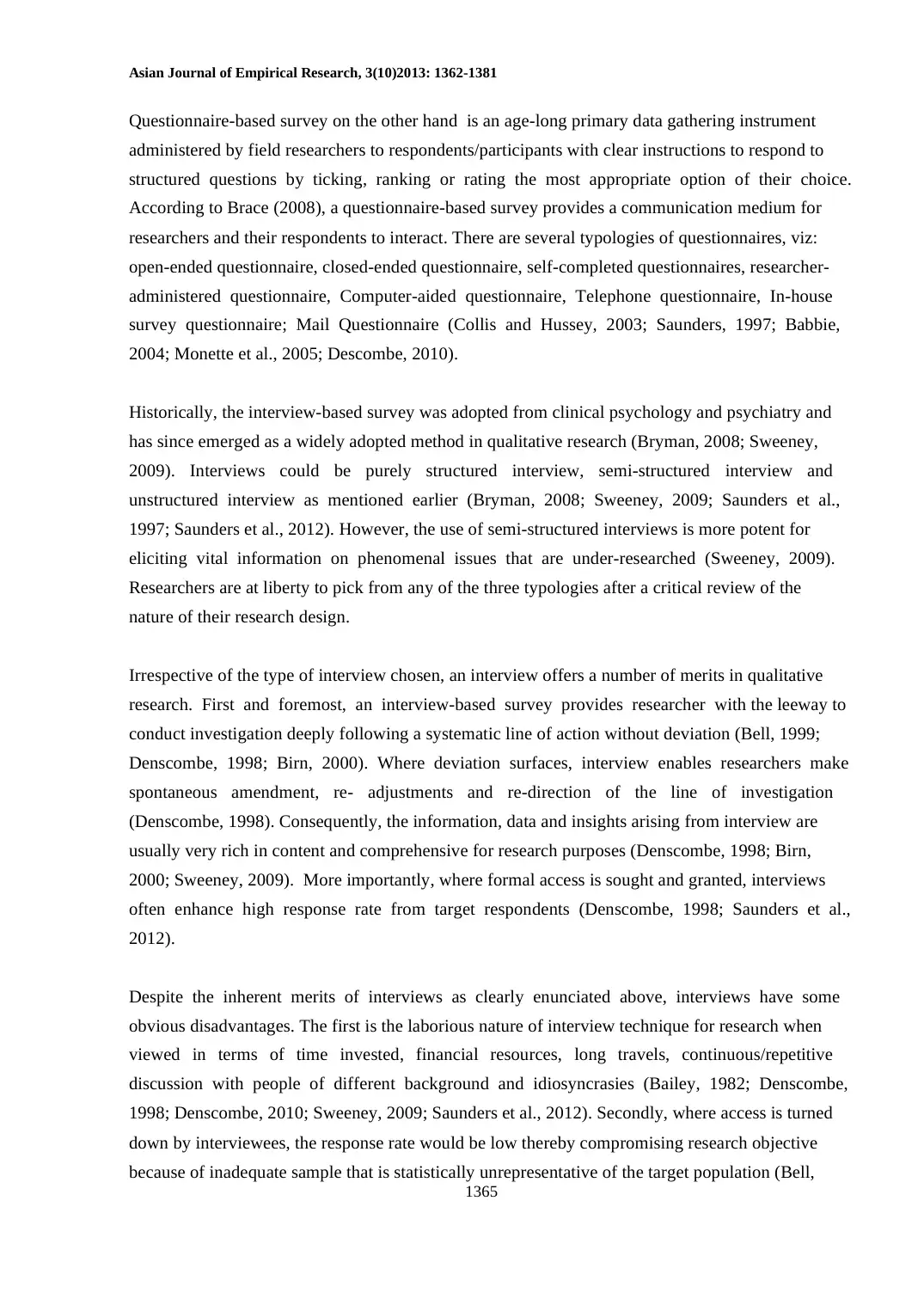
Asian Journal of Empirical Research, 3(10)2013: 1362-1381
1365
Questionnaire-based survey on the other hand is an age-long primary data gathering instrument
administered by field researchers to respondents/participants with clear instructions to respond to
structured questions by ticking, ranking or rating the most appropriate option of their choice.
According to Brace (2008), a questionnaire-based survey provides a communication medium for
researchers and their respondents to interact. There are several typologies of questionnaires, viz:
open-ended questionnaire, closed-ended questionnaire, self-completed questionnaires, researcher-
administered questionnaire, Computer-aided questionnaire, Telephone questionnaire, In-house
survey questionnaire; Mail Questionnaire (Collis and Hussey, 2003; Saunders, 1997; Babbie,
2004; Monette et al., 2005; Descombe, 2010).
Historically, the interview-based survey was adopted from clinical psychology and psychiatry and
has since emerged as a widely adopted method in qualitative research (Bryman, 2008; Sweeney,
2009). Interviews could be purely structured interview, semi-structured interview and
unstructured interview as mentioned earlier (Bryman, 2008; Sweeney, 2009; Saunders et al.,
1997; Saunders et al., 2012). However, the use of semi-structured interviews is more potent for
eliciting vital information on phenomenal issues that are under-researched (Sweeney, 2009).
Researchers are at liberty to pick from any of the three typologies after a critical review of the
nature of their research design.
Irrespective of the type of interview chosen, an interview offers a number of merits in qualitative
research. First and foremost, an interview-based survey provides researcher with the leeway to
conduct investigation deeply following a systematic line of action without deviation (Bell, 1999;
Denscombe, 1998; Birn, 2000). Where deviation surfaces, interview enables researchers make
spontaneous amendment, re- adjustments and re-direction of the line of investigation
(Denscombe, 1998). Consequently, the information, data and insights arising from interview are
usually very rich in content and comprehensive for research purposes (Denscombe, 1998; Birn,
2000; Sweeney, 2009). More importantly, where formal access is sought and granted, interviews
often enhance high response rate from target respondents (Denscombe, 1998; Saunders et al.,
2012).
Despite the inherent merits of interviews as clearly enunciated above, interviews have some
obvious disadvantages. The first is the laborious nature of interview technique for research when
viewed in terms of time invested, financial resources, long travels, continuous/repetitive
discussion with people of different background and idiosyncrasies (Bailey, 1982; Denscombe,
1998; Denscombe, 2010; Sweeney, 2009; Saunders et al., 2012). Secondly, where access is turned
down by interviewees, the response rate would be low thereby compromising research objective
because of inadequate sample that is statistically unrepresentative of the target population (Bell,
1365
Questionnaire-based survey on the other hand is an age-long primary data gathering instrument
administered by field researchers to respondents/participants with clear instructions to respond to
structured questions by ticking, ranking or rating the most appropriate option of their choice.
According to Brace (2008), a questionnaire-based survey provides a communication medium for
researchers and their respondents to interact. There are several typologies of questionnaires, viz:
open-ended questionnaire, closed-ended questionnaire, self-completed questionnaires, researcher-
administered questionnaire, Computer-aided questionnaire, Telephone questionnaire, In-house
survey questionnaire; Mail Questionnaire (Collis and Hussey, 2003; Saunders, 1997; Babbie,
2004; Monette et al., 2005; Descombe, 2010).
Historically, the interview-based survey was adopted from clinical psychology and psychiatry and
has since emerged as a widely adopted method in qualitative research (Bryman, 2008; Sweeney,
2009). Interviews could be purely structured interview, semi-structured interview and
unstructured interview as mentioned earlier (Bryman, 2008; Sweeney, 2009; Saunders et al.,
1997; Saunders et al., 2012). However, the use of semi-structured interviews is more potent for
eliciting vital information on phenomenal issues that are under-researched (Sweeney, 2009).
Researchers are at liberty to pick from any of the three typologies after a critical review of the
nature of their research design.
Irrespective of the type of interview chosen, an interview offers a number of merits in qualitative
research. First and foremost, an interview-based survey provides researcher with the leeway to
conduct investigation deeply following a systematic line of action without deviation (Bell, 1999;
Denscombe, 1998; Birn, 2000). Where deviation surfaces, interview enables researchers make
spontaneous amendment, re- adjustments and re-direction of the line of investigation
(Denscombe, 1998). Consequently, the information, data and insights arising from interview are
usually very rich in content and comprehensive for research purposes (Denscombe, 1998; Birn,
2000; Sweeney, 2009). More importantly, where formal access is sought and granted, interviews
often enhance high response rate from target respondents (Denscombe, 1998; Saunders et al.,
2012).
Despite the inherent merits of interviews as clearly enunciated above, interviews have some
obvious disadvantages. The first is the laborious nature of interview technique for research when
viewed in terms of time invested, financial resources, long travels, continuous/repetitive
discussion with people of different background and idiosyncrasies (Bailey, 1982; Denscombe,
1998; Denscombe, 2010; Sweeney, 2009; Saunders et al., 2012). Secondly, where access is turned
down by interviewees, the response rate would be low thereby compromising research objective
because of inadequate sample that is statistically unrepresentative of the target population (Bell,
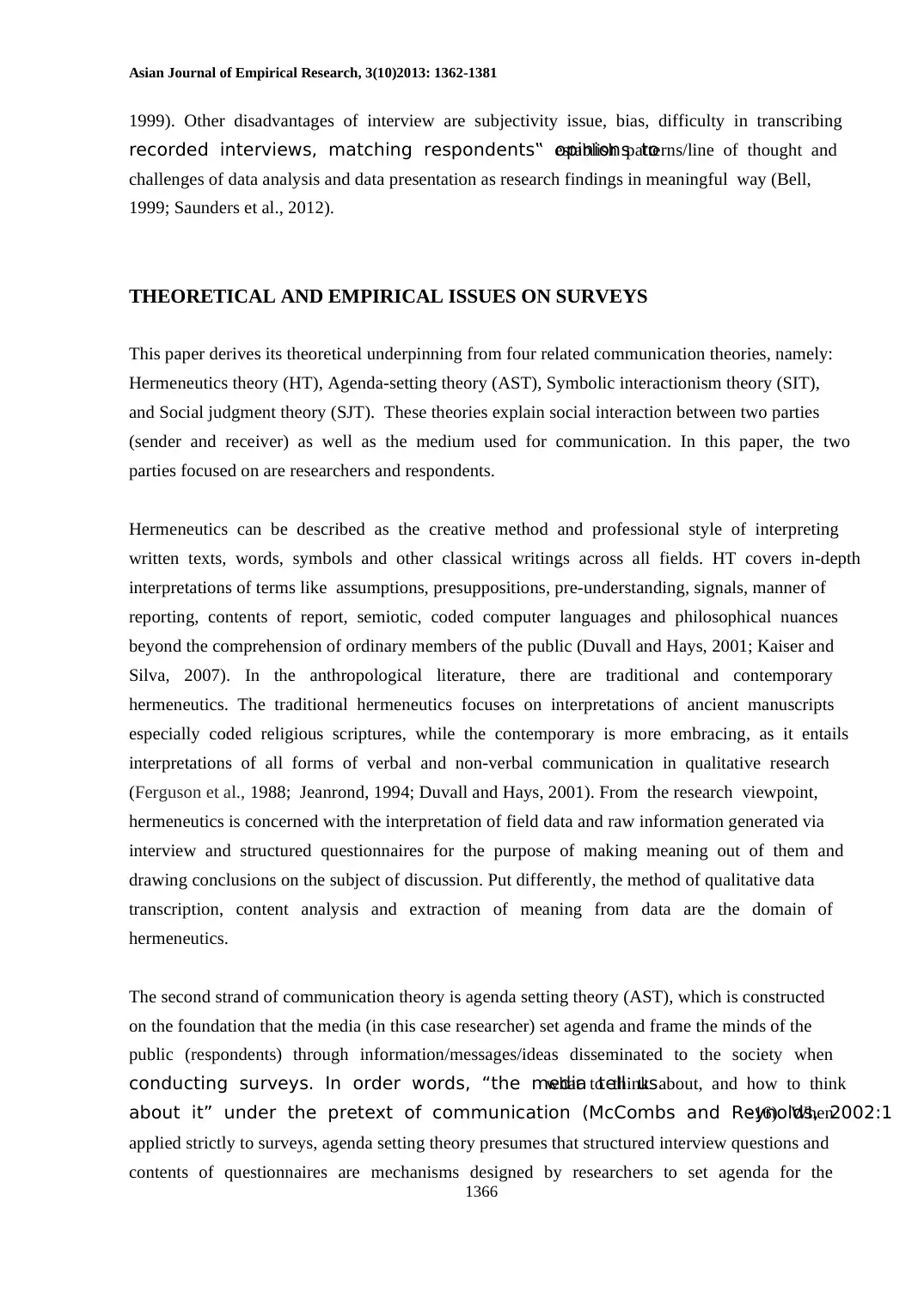
Asian Journal of Empirical Research, 3(10)2013: 1362-1381
1366
1999). Other disadvantages of interview are subjectivity issue, bias, difficulty in transcribing
recorded interviews, matching respondents‟ opinions toestablish patterns/line of thought and
challenges of data analysis and data presentation as research findings in meaningful way (Bell,
1999; Saunders et al., 2012).
THEORETICAL AND EMPIRICAL ISSUES ON SURVEYS
This paper derives its theoretical underpinning from four related communication theories, namely:
Hermeneutics theory (HT), Agenda-setting theory (AST), Symbolic interactionism theory (SIT),
and Social judgment theory (SJT). These theories explain social interaction between two parties
(sender and receiver) as well as the medium used for communication. In this paper, the two
parties focused on are researchers and respondents.
Hermeneutics can be described as the creative method and professional style of interpreting
written texts, words, symbols and other classical writings across all fields. HT covers in-depth
interpretations of terms like assumptions, presuppositions, pre-understanding, signals, manner of
reporting, contents of report, semiotic, coded computer languages and philosophical nuances
beyond the comprehension of ordinary members of the public (Duvall and Hays, 2001; Kaiser and
Silva, 2007). In the anthropological literature, there are traditional and contemporary
hermeneutics. The traditional hermeneutics focuses on interpretations of ancient manuscripts
especially coded religious scriptures, while the contemporary is more embracing, as it entails
interpretations of all forms of verbal and non-verbal communication in qualitative research
(Ferguson et al., 1988; Jeanrond, 1994; Duvall and Hays, 2001). From the research viewpoint,
hermeneutics is concerned with the interpretation of field data and raw information generated via
interview and structured questionnaires for the purpose of making meaning out of them and
drawing conclusions on the subject of discussion. Put differently, the method of qualitative data
transcription, content analysis and extraction of meaning from data are the domain of
hermeneutics.
The second strand of communication theory is agenda setting theory (AST), which is constructed
on the foundation that the media (in this case researcher) set agenda and frame the minds of the
public (respondents) through information/messages/ideas disseminated to the society when
conducting surveys. In order words, “the media tell uswhat to think about, and how to think
about it” under the pretext of communication (McCombs and Reynolds, 2002:1-16). When
applied strictly to surveys, agenda setting theory presumes that structured interview questions and
contents of questionnaires are mechanisms designed by researchers to set agenda for the
1366
1999). Other disadvantages of interview are subjectivity issue, bias, difficulty in transcribing
recorded interviews, matching respondents‟ opinions toestablish patterns/line of thought and
challenges of data analysis and data presentation as research findings in meaningful way (Bell,
1999; Saunders et al., 2012).
THEORETICAL AND EMPIRICAL ISSUES ON SURVEYS
This paper derives its theoretical underpinning from four related communication theories, namely:
Hermeneutics theory (HT), Agenda-setting theory (AST), Symbolic interactionism theory (SIT),
and Social judgment theory (SJT). These theories explain social interaction between two parties
(sender and receiver) as well as the medium used for communication. In this paper, the two
parties focused on are researchers and respondents.
Hermeneutics can be described as the creative method and professional style of interpreting
written texts, words, symbols and other classical writings across all fields. HT covers in-depth
interpretations of terms like assumptions, presuppositions, pre-understanding, signals, manner of
reporting, contents of report, semiotic, coded computer languages and philosophical nuances
beyond the comprehension of ordinary members of the public (Duvall and Hays, 2001; Kaiser and
Silva, 2007). In the anthropological literature, there are traditional and contemporary
hermeneutics. The traditional hermeneutics focuses on interpretations of ancient manuscripts
especially coded religious scriptures, while the contemporary is more embracing, as it entails
interpretations of all forms of verbal and non-verbal communication in qualitative research
(Ferguson et al., 1988; Jeanrond, 1994; Duvall and Hays, 2001). From the research viewpoint,
hermeneutics is concerned with the interpretation of field data and raw information generated via
interview and structured questionnaires for the purpose of making meaning out of them and
drawing conclusions on the subject of discussion. Put differently, the method of qualitative data
transcription, content analysis and extraction of meaning from data are the domain of
hermeneutics.
The second strand of communication theory is agenda setting theory (AST), which is constructed
on the foundation that the media (in this case researcher) set agenda and frame the minds of the
public (respondents) through information/messages/ideas disseminated to the society when
conducting surveys. In order words, “the media tell uswhat to think about, and how to think
about it” under the pretext of communication (McCombs and Reynolds, 2002:1-16). When
applied strictly to surveys, agenda setting theory presumes that structured interview questions and
contents of questionnaires are mechanisms designed by researchers to set agenda for the
⊘ This is a preview!⊘
Do you want full access?
Subscribe today to unlock all pages.

Trusted by 1+ million students worldwide
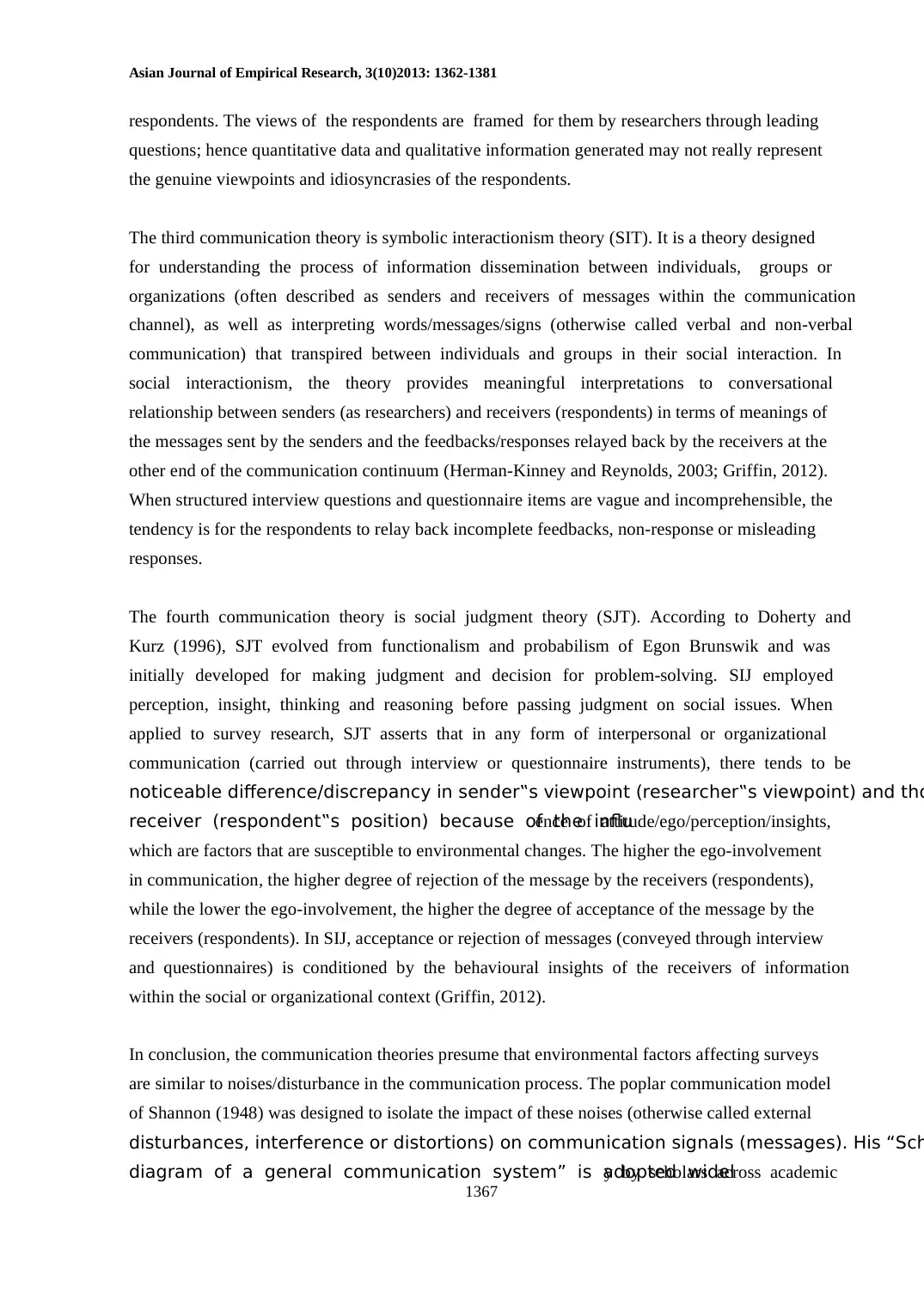
Asian Journal of Empirical Research, 3(10)2013: 1362-1381
1367
respondents. The views of the respondents are framed for them by researchers through leading
questions; hence quantitative data and qualitative information generated may not really represent
the genuine viewpoints and idiosyncrasies of the respondents.
The third communication theory is symbolic interactionism theory (SIT). It is a theory designed
for understanding the process of information dissemination between individuals, groups or
organizations (often described as senders and receivers of messages within the communication
channel), as well as interpreting words/messages/signs (otherwise called verbal and non-verbal
communication) that transpired between individuals and groups in their social interaction. In
social interactionism, the theory provides meaningful interpretations to conversational
relationship between senders (as researchers) and receivers (respondents) in terms of meanings of
the messages sent by the senders and the feedbacks/responses relayed back by the receivers at the
other end of the communication continuum (Herman-Kinney and Reynolds, 2003; Griffin, 2012).
When structured interview questions and questionnaire items are vague and incomprehensible, the
tendency is for the respondents to relay back incomplete feedbacks, non-response or misleading
responses.
The fourth communication theory is social judgment theory (SJT). According to Doherty and
Kurz (1996), SJT evolved from functionalism and probabilism of Egon Brunswik and was
initially developed for making judgment and decision for problem-solving. SIJ employed
perception, insight, thinking and reasoning before passing judgment on social issues. When
applied to survey research, SJT asserts that in any form of interpersonal or organizational
communication (carried out through interview or questionnaire instruments), there tends to be
noticeable difference/discrepancy in sender‟s viewpoint (researcher‟s viewpoint) and tho
receiver (respondent‟s position) because of the influence of attitude/ego/perception/insights,
which are factors that are susceptible to environmental changes. The higher the ego-involvement
in communication, the higher degree of rejection of the message by the receivers (respondents),
while the lower the ego-involvement, the higher the degree of acceptance of the message by the
receivers (respondents). In SIJ, acceptance or rejection of messages (conveyed through interview
and questionnaires) is conditioned by the behavioural insights of the receivers of information
within the social or organizational context (Griffin, 2012).
In conclusion, the communication theories presume that environmental factors affecting surveys
are similar to noises/disturbance in the communication process. The poplar communication model
of Shannon (1948) was designed to isolate the impact of these noises (otherwise called external
disturbances, interference or distortions) on communication signals (messages). His “Sch
diagram of a general communication system” is adopted widely by scholars across academic
1367
respondents. The views of the respondents are framed for them by researchers through leading
questions; hence quantitative data and qualitative information generated may not really represent
the genuine viewpoints and idiosyncrasies of the respondents.
The third communication theory is symbolic interactionism theory (SIT). It is a theory designed
for understanding the process of information dissemination between individuals, groups or
organizations (often described as senders and receivers of messages within the communication
channel), as well as interpreting words/messages/signs (otherwise called verbal and non-verbal
communication) that transpired between individuals and groups in their social interaction. In
social interactionism, the theory provides meaningful interpretations to conversational
relationship between senders (as researchers) and receivers (respondents) in terms of meanings of
the messages sent by the senders and the feedbacks/responses relayed back by the receivers at the
other end of the communication continuum (Herman-Kinney and Reynolds, 2003; Griffin, 2012).
When structured interview questions and questionnaire items are vague and incomprehensible, the
tendency is for the respondents to relay back incomplete feedbacks, non-response or misleading
responses.
The fourth communication theory is social judgment theory (SJT). According to Doherty and
Kurz (1996), SJT evolved from functionalism and probabilism of Egon Brunswik and was
initially developed for making judgment and decision for problem-solving. SIJ employed
perception, insight, thinking and reasoning before passing judgment on social issues. When
applied to survey research, SJT asserts that in any form of interpersonal or organizational
communication (carried out through interview or questionnaire instruments), there tends to be
noticeable difference/discrepancy in sender‟s viewpoint (researcher‟s viewpoint) and tho
receiver (respondent‟s position) because of the influence of attitude/ego/perception/insights,
which are factors that are susceptible to environmental changes. The higher the ego-involvement
in communication, the higher degree of rejection of the message by the receivers (respondents),
while the lower the ego-involvement, the higher the degree of acceptance of the message by the
receivers (respondents). In SIJ, acceptance or rejection of messages (conveyed through interview
and questionnaires) is conditioned by the behavioural insights of the receivers of information
within the social or organizational context (Griffin, 2012).
In conclusion, the communication theories presume that environmental factors affecting surveys
are similar to noises/disturbance in the communication process. The poplar communication model
of Shannon (1948) was designed to isolate the impact of these noises (otherwise called external
disturbances, interference or distortions) on communication signals (messages). His “Sch
diagram of a general communication system” is adopted widely by scholars across academic
Paraphrase This Document
Need a fresh take? Get an instant paraphrase of this document with our AI Paraphraser
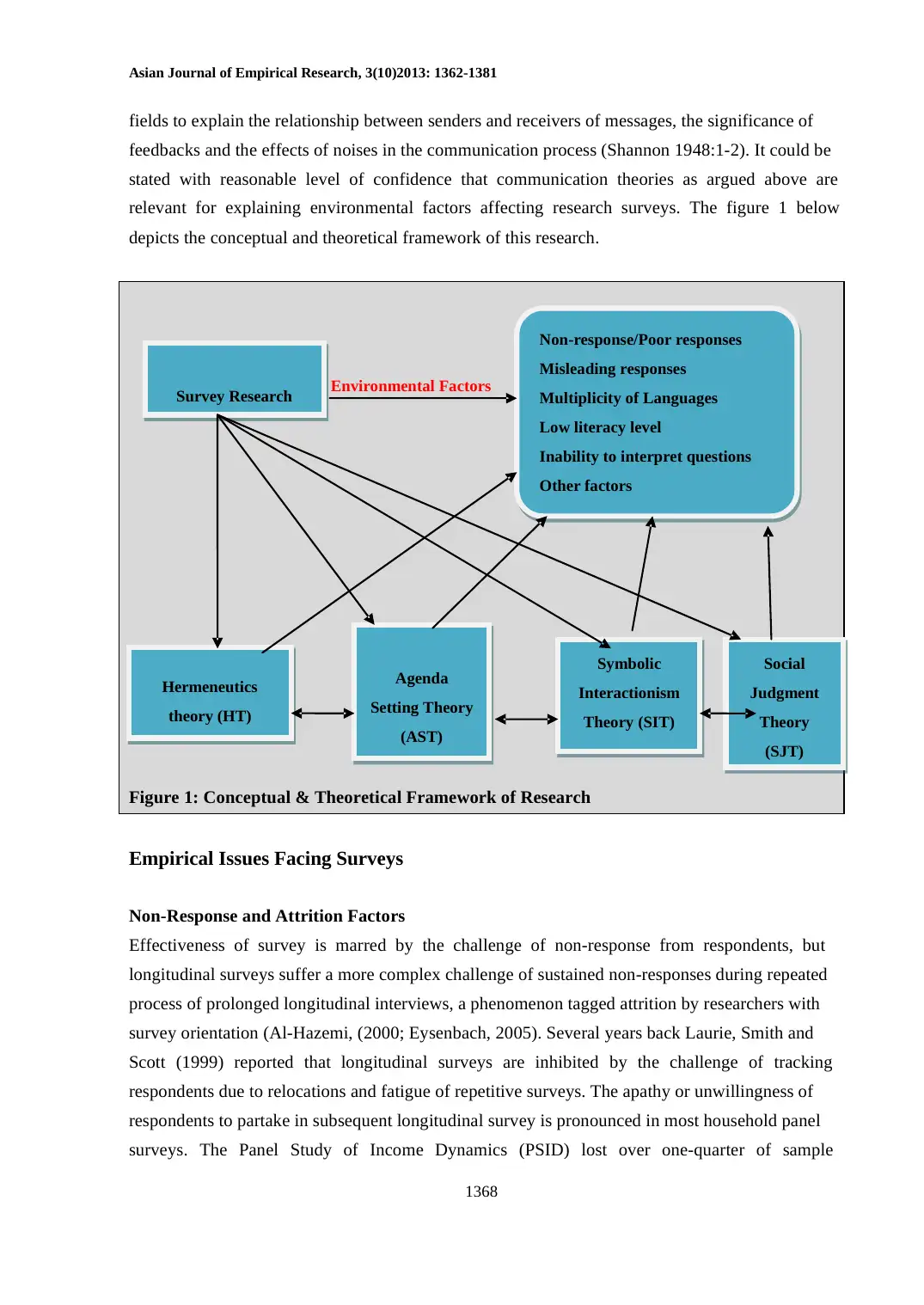
Asian Journal of Empirical Research, 3(10)2013: 1362-1381
1368
fields to explain the relationship between senders and receivers of messages, the significance of
feedbacks and the effects of noises in the communication process (Shannon 1948:1-2). It could be
stated with reasonable level of confidence that communication theories as argued above are
relevant for explaining environmental factors affecting research surveys. The figure 1 below
depicts the conceptual and theoretical framework of this research.
Environmental Factors
Figure 1: Conceptual & Theoretical Framework of Research
Empirical Issues Facing Surveys
Non-Response and Attrition Factors
Effectiveness of survey is marred by the challenge of non-response from respondents, but
longitudinal surveys suffer a more complex challenge of sustained non-responses during repeated
process of prolonged longitudinal interviews, a phenomenon tagged attrition by researchers with
survey orientation (Al-Hazemi, (2000; Eysenbach, 2005). Several years back Laurie, Smith and
Scott (1999) reported that longitudinal surveys are inhibited by the challenge of tracking
respondents due to relocations and fatigue of repetitive surveys. The apathy or unwillingness of
respondents to partake in subsequent longitudinal survey is pronounced in most household panel
surveys. The Panel Study of Income Dynamics (PSID) lost over one-quarter of sample
Survey Research
Non-response/Poor responses
Misleading responses
Multiplicity of Languages
Low literacy level
Inability to interpret questions
Other factors
Hermeneutics
theory (HT)
Agenda
Setting Theory
(AST)
Symbolic
Interactionism
Theory (SIT)
Social
Judgment
Theory
(SJT)
1368
fields to explain the relationship between senders and receivers of messages, the significance of
feedbacks and the effects of noises in the communication process (Shannon 1948:1-2). It could be
stated with reasonable level of confidence that communication theories as argued above are
relevant for explaining environmental factors affecting research surveys. The figure 1 below
depicts the conceptual and theoretical framework of this research.
Environmental Factors
Figure 1: Conceptual & Theoretical Framework of Research
Empirical Issues Facing Surveys
Non-Response and Attrition Factors
Effectiveness of survey is marred by the challenge of non-response from respondents, but
longitudinal surveys suffer a more complex challenge of sustained non-responses during repeated
process of prolonged longitudinal interviews, a phenomenon tagged attrition by researchers with
survey orientation (Al-Hazemi, (2000; Eysenbach, 2005). Several years back Laurie, Smith and
Scott (1999) reported that longitudinal surveys are inhibited by the challenge of tracking
respondents due to relocations and fatigue of repetitive surveys. The apathy or unwillingness of
respondents to partake in subsequent longitudinal survey is pronounced in most household panel
surveys. The Panel Study of Income Dynamics (PSID) lost over one-quarter of sample
Survey Research
Non-response/Poor responses
Misleading responses
Multiplicity of Languages
Low literacy level
Inability to interpret questions
Other factors
Hermeneutics
theory (HT)
Agenda
Setting Theory
(AST)
Symbolic
Interactionism
Theory (SIT)
Social
Judgment
Theory
(SJT)
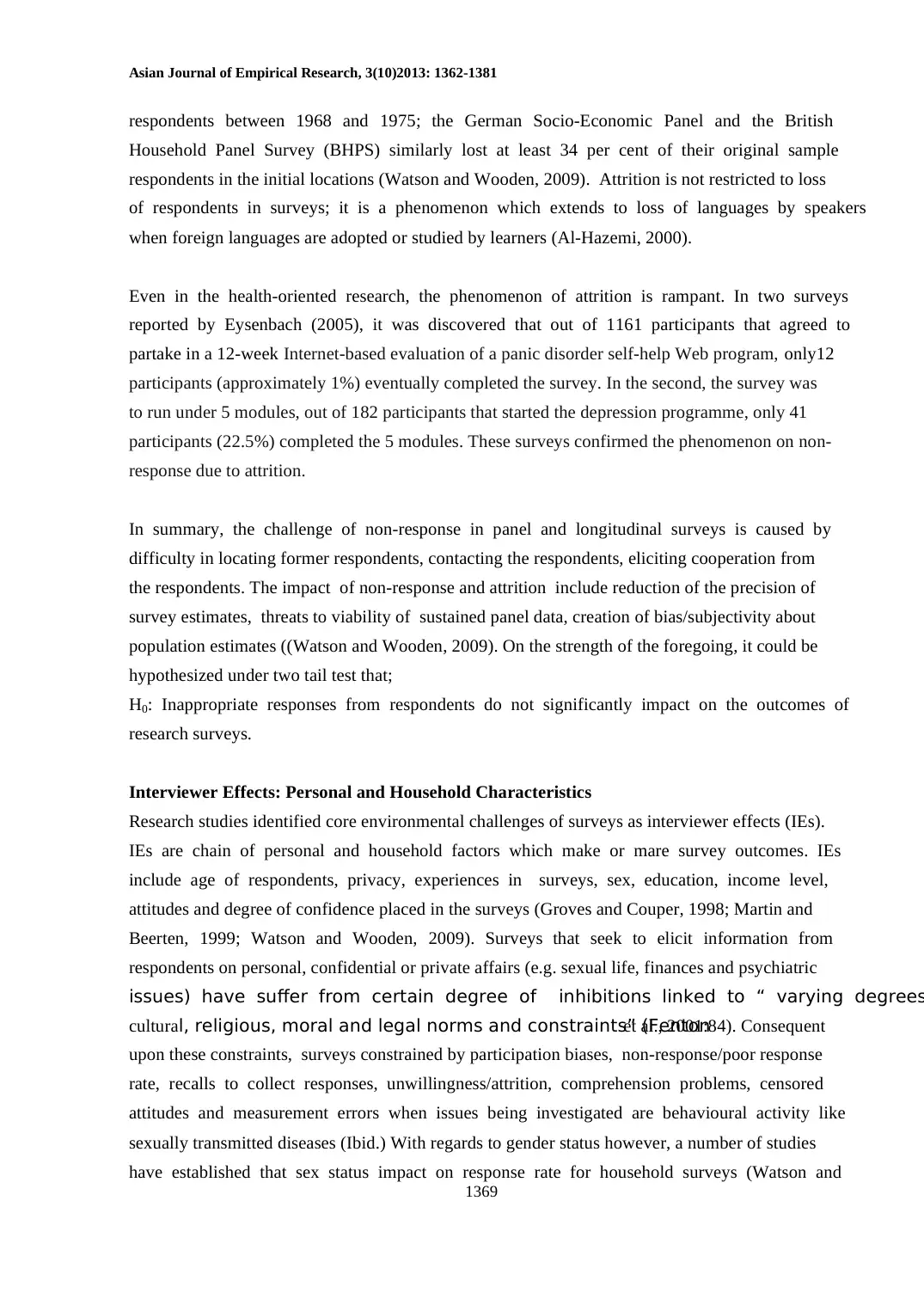
Asian Journal of Empirical Research, 3(10)2013: 1362-1381
1369
respondents between 1968 and 1975; the German Socio-Economic Panel and the British
Household Panel Survey (BHPS) similarly lost at least 34 per cent of their original sample
respondents in the initial locations (Watson and Wooden, 2009). Attrition is not restricted to loss
of respondents in surveys; it is a phenomenon which extends to loss of languages by speakers
when foreign languages are adopted or studied by learners (Al-Hazemi, 2000).
Even in the health-oriented research, the phenomenon of attrition is rampant. In two surveys
reported by Eysenbach (2005), it was discovered that out of 1161 participants that agreed to
partake in a 12-week Internet-based evaluation of a panic disorder self-help Web program, only12
participants (approximately 1%) eventually completed the survey. In the second, the survey was
to run under 5 modules, out of 182 participants that started the depression programme, only 41
participants (22.5%) completed the 5 modules. These surveys confirmed the phenomenon on non-
response due to attrition.
In summary, the challenge of non-response in panel and longitudinal surveys is caused by
difficulty in locating former respondents, contacting the respondents, eliciting cooperation from
the respondents. The impact of non-response and attrition include reduction of the precision of
survey estimates, threats to viability of sustained panel data, creation of bias/subjectivity about
population estimates ((Watson and Wooden, 2009). On the strength of the foregoing, it could be
hypothesized under two tail test that;
H0: Inappropriate responses from respondents do not significantly impact on the outcomes of
research surveys.
Interviewer Effects: Personal and Household Characteristics
Research studies identified core environmental challenges of surveys as interviewer effects (IEs).
IEs are chain of personal and household factors which make or mare survey outcomes. IEs
include age of respondents, privacy, experiences in surveys, sex, education, income level,
attitudes and degree of confidence placed in the surveys (Groves and Couper, 1998; Martin and
Beerten, 1999; Watson and Wooden, 2009). Surveys that seek to elicit information from
respondents on personal, confidential or private affairs (e.g. sexual life, finances and psychiatric
issues) have suffer from certain degree of inhibitions linked to “ varying degrees
cultural, religious, moral and legal norms and constraints” (Fentonet al., 2001:84). Consequent
upon these constraints, surveys constrained by participation biases, non-response/poor response
rate, recalls to collect responses, unwillingness/attrition, comprehension problems, censored
attitudes and measurement errors when issues being investigated are behavioural activity like
sexually transmitted diseases (Ibid.) With regards to gender status however, a number of studies
have established that sex status impact on response rate for household surveys (Watson and
1369
respondents between 1968 and 1975; the German Socio-Economic Panel and the British
Household Panel Survey (BHPS) similarly lost at least 34 per cent of their original sample
respondents in the initial locations (Watson and Wooden, 2009). Attrition is not restricted to loss
of respondents in surveys; it is a phenomenon which extends to loss of languages by speakers
when foreign languages are adopted or studied by learners (Al-Hazemi, 2000).
Even in the health-oriented research, the phenomenon of attrition is rampant. In two surveys
reported by Eysenbach (2005), it was discovered that out of 1161 participants that agreed to
partake in a 12-week Internet-based evaluation of a panic disorder self-help Web program, only12
participants (approximately 1%) eventually completed the survey. In the second, the survey was
to run under 5 modules, out of 182 participants that started the depression programme, only 41
participants (22.5%) completed the 5 modules. These surveys confirmed the phenomenon on non-
response due to attrition.
In summary, the challenge of non-response in panel and longitudinal surveys is caused by
difficulty in locating former respondents, contacting the respondents, eliciting cooperation from
the respondents. The impact of non-response and attrition include reduction of the precision of
survey estimates, threats to viability of sustained panel data, creation of bias/subjectivity about
population estimates ((Watson and Wooden, 2009). On the strength of the foregoing, it could be
hypothesized under two tail test that;
H0: Inappropriate responses from respondents do not significantly impact on the outcomes of
research surveys.
Interviewer Effects: Personal and Household Characteristics
Research studies identified core environmental challenges of surveys as interviewer effects (IEs).
IEs are chain of personal and household factors which make or mare survey outcomes. IEs
include age of respondents, privacy, experiences in surveys, sex, education, income level,
attitudes and degree of confidence placed in the surveys (Groves and Couper, 1998; Martin and
Beerten, 1999; Watson and Wooden, 2009). Surveys that seek to elicit information from
respondents on personal, confidential or private affairs (e.g. sexual life, finances and psychiatric
issues) have suffer from certain degree of inhibitions linked to “ varying degrees
cultural, religious, moral and legal norms and constraints” (Fentonet al., 2001:84). Consequent
upon these constraints, surveys constrained by participation biases, non-response/poor response
rate, recalls to collect responses, unwillingness/attrition, comprehension problems, censored
attitudes and measurement errors when issues being investigated are behavioural activity like
sexually transmitted diseases (Ibid.) With regards to gender status however, a number of studies
have established that sex status impact on response rate for household surveys (Watson and
⊘ This is a preview!⊘
Do you want full access?
Subscribe today to unlock all pages.

Trusted by 1+ million students worldwide
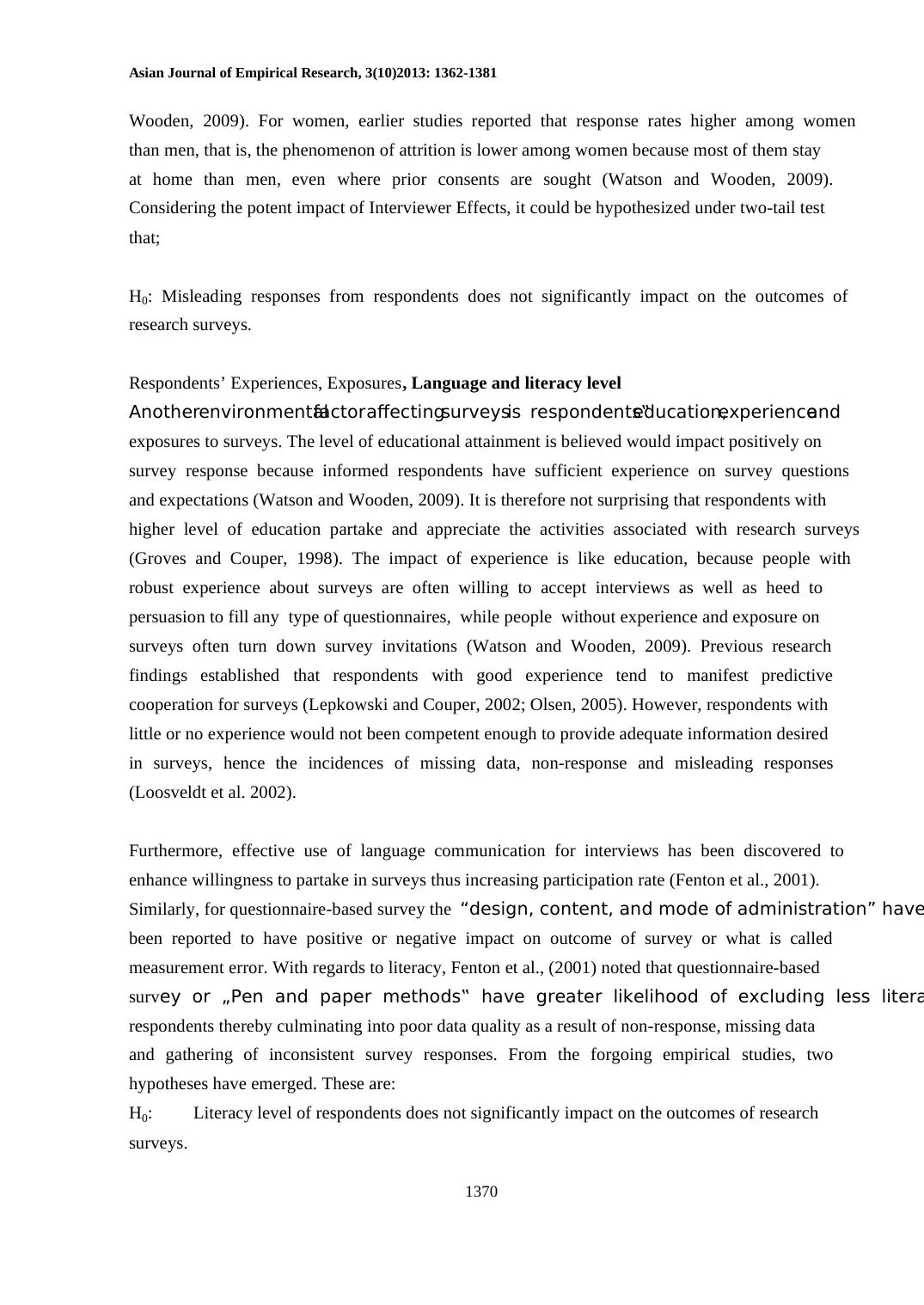
Asian Journal of Empirical Research, 3(10)2013: 1362-1381
1370
Wooden, 2009). For women, earlier studies reported that response rates higher among women
than men, that is, the phenomenon of attrition is lower among women because most of them stay
at home than men, even where prior consents are sought (Watson and Wooden, 2009).
Considering the potent impact of Interviewer Effects, it could be hypothesized under two-tail test
that;
H0: Misleading responses from respondents does not significantly impact on the outcomes of
research surveys.
Respondents’ Experiences, Exposures, Language and literacy level
Anotherenvironmentalfactor affectingsurveysis respondents‟education,experienceand
exposures to surveys. The level of educational attainment is believed would impact positively on
survey response because informed respondents have sufficient experience on survey questions
and expectations (Watson and Wooden, 2009). It is therefore not surprising that respondents with
higher level of education partake and appreciate the activities associated with research surveys
(Groves and Couper, 1998). The impact of experience is like education, because people with
robust experience about surveys are often willing to accept interviews as well as heed to
persuasion to fill any type of questionnaires, while people without experience and exposure on
surveys often turn down survey invitations (Watson and Wooden, 2009). Previous research
findings established that respondents with good experience tend to manifest predictive
cooperation for surveys (Lepkowski and Couper, 2002; Olsen, 2005). However, respondents with
little or no experience would not been competent enough to provide adequate information desired
in surveys, hence the incidences of missing data, non-response and misleading responses
(Loosveldt et al. 2002).
Furthermore, effective use of language communication for interviews has been discovered to
enhance willingness to partake in surveys thus increasing participation rate (Fenton et al., 2001).
Similarly, for questionnaire-based survey the “design, content, and mode of administration” have
been reported to have positive or negative impact on outcome of survey or what is called
measurement error. With regards to literacy, Fenton et al., (2001) noted that questionnaire-based
survey or „Pen and paper methods‟ have greater likelihood of excluding less litera
respondents thereby culminating into poor data quality as a result of non-response, missing data
and gathering of inconsistent survey responses. From the forgoing empirical studies, two
hypotheses have emerged. These are:
H0: Literacy level of respondents does not significantly impact on the outcomes of research
surveys.
1370
Wooden, 2009). For women, earlier studies reported that response rates higher among women
than men, that is, the phenomenon of attrition is lower among women because most of them stay
at home than men, even where prior consents are sought (Watson and Wooden, 2009).
Considering the potent impact of Interviewer Effects, it could be hypothesized under two-tail test
that;
H0: Misleading responses from respondents does not significantly impact on the outcomes of
research surveys.
Respondents’ Experiences, Exposures, Language and literacy level
Anotherenvironmentalfactor affectingsurveysis respondents‟education,experienceand
exposures to surveys. The level of educational attainment is believed would impact positively on
survey response because informed respondents have sufficient experience on survey questions
and expectations (Watson and Wooden, 2009). It is therefore not surprising that respondents with
higher level of education partake and appreciate the activities associated with research surveys
(Groves and Couper, 1998). The impact of experience is like education, because people with
robust experience about surveys are often willing to accept interviews as well as heed to
persuasion to fill any type of questionnaires, while people without experience and exposure on
surveys often turn down survey invitations (Watson and Wooden, 2009). Previous research
findings established that respondents with good experience tend to manifest predictive
cooperation for surveys (Lepkowski and Couper, 2002; Olsen, 2005). However, respondents with
little or no experience would not been competent enough to provide adequate information desired
in surveys, hence the incidences of missing data, non-response and misleading responses
(Loosveldt et al. 2002).
Furthermore, effective use of language communication for interviews has been discovered to
enhance willingness to partake in surveys thus increasing participation rate (Fenton et al., 2001).
Similarly, for questionnaire-based survey the “design, content, and mode of administration” have
been reported to have positive or negative impact on outcome of survey or what is called
measurement error. With regards to literacy, Fenton et al., (2001) noted that questionnaire-based
survey or „Pen and paper methods‟ have greater likelihood of excluding less litera
respondents thereby culminating into poor data quality as a result of non-response, missing data
and gathering of inconsistent survey responses. From the forgoing empirical studies, two
hypotheses have emerged. These are:
H0: Literacy level of respondents does not significantly impact on the outcomes of research
surveys.
Paraphrase This Document
Need a fresh take? Get an instant paraphrase of this document with our AI Paraphraser
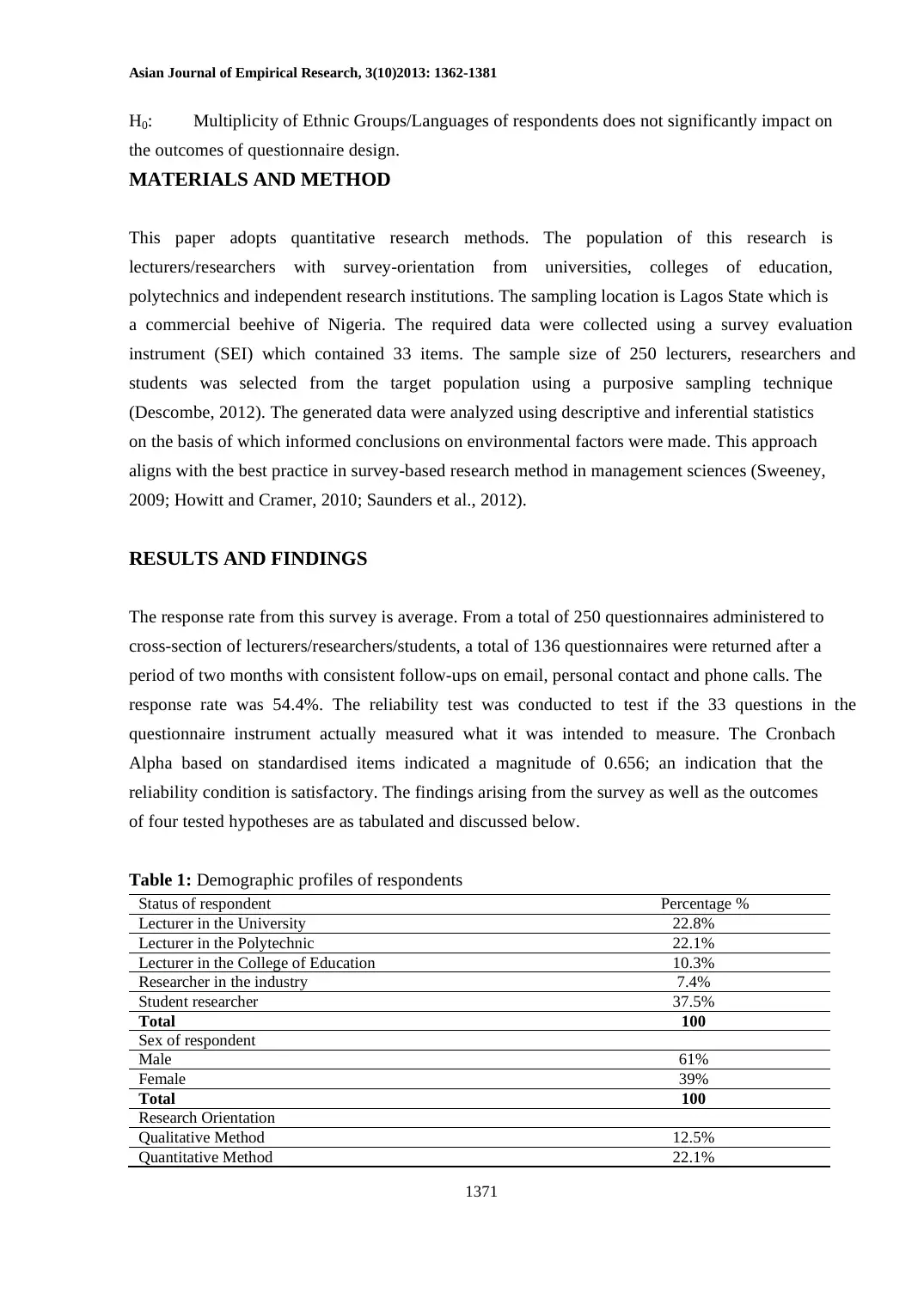
Asian Journal of Empirical Research, 3(10)2013: 1362-1381
1371
H0: Multiplicity of Ethnic Groups/Languages of respondents does not significantly impact on
the outcomes of questionnaire design.
MATERIALS AND METHOD
This paper adopts quantitative research methods. The population of this research is
lecturers/researchers with survey-orientation from universities, colleges of education,
polytechnics and independent research institutions. The sampling location is Lagos State which is
a commercial beehive of Nigeria. The required data were collected using a survey evaluation
instrument (SEI) which contained 33 items. The sample size of 250 lecturers, researchers and
students was selected from the target population using a purposive sampling technique
(Descombe, 2012). The generated data were analyzed using descriptive and inferential statistics
on the basis of which informed conclusions on environmental factors were made. This approach
aligns with the best practice in survey-based research method in management sciences (Sweeney,
2009; Howitt and Cramer, 2010; Saunders et al., 2012).
RESULTS AND FINDINGS
The response rate from this survey is average. From a total of 250 questionnaires administered to
cross-section of lecturers/researchers/students, a total of 136 questionnaires were returned after a
period of two months with consistent follow-ups on email, personal contact and phone calls. The
response rate was 54.4%. The reliability test was conducted to test if the 33 questions in the
questionnaire instrument actually measured what it was intended to measure. The Cronbach
Alpha based on standardised items indicated a magnitude of 0.656; an indication that the
reliability condition is satisfactory. The findings arising from the survey as well as the outcomes
of four tested hypotheses are as tabulated and discussed below.
Table 1: Demographic profiles of respondents
Status of respondent Percentage %
Lecturer in the University 22.8%
Lecturer in the Polytechnic 22.1%
Lecturer in the College of Education 10.3%
Researcher in the industry 7.4%
Student researcher 37.5%
Total 100
Sex of respondent
Male 61%
Female 39%
Total 100
Research Orientation
Qualitative Method 12.5%
Quantitative Method 22.1%
1371
H0: Multiplicity of Ethnic Groups/Languages of respondents does not significantly impact on
the outcomes of questionnaire design.
MATERIALS AND METHOD
This paper adopts quantitative research methods. The population of this research is
lecturers/researchers with survey-orientation from universities, colleges of education,
polytechnics and independent research institutions. The sampling location is Lagos State which is
a commercial beehive of Nigeria. The required data were collected using a survey evaluation
instrument (SEI) which contained 33 items. The sample size of 250 lecturers, researchers and
students was selected from the target population using a purposive sampling technique
(Descombe, 2012). The generated data were analyzed using descriptive and inferential statistics
on the basis of which informed conclusions on environmental factors were made. This approach
aligns with the best practice in survey-based research method in management sciences (Sweeney,
2009; Howitt and Cramer, 2010; Saunders et al., 2012).
RESULTS AND FINDINGS
The response rate from this survey is average. From a total of 250 questionnaires administered to
cross-section of lecturers/researchers/students, a total of 136 questionnaires were returned after a
period of two months with consistent follow-ups on email, personal contact and phone calls. The
response rate was 54.4%. The reliability test was conducted to test if the 33 questions in the
questionnaire instrument actually measured what it was intended to measure. The Cronbach
Alpha based on standardised items indicated a magnitude of 0.656; an indication that the
reliability condition is satisfactory. The findings arising from the survey as well as the outcomes
of four tested hypotheses are as tabulated and discussed below.
Table 1: Demographic profiles of respondents
Status of respondent Percentage %
Lecturer in the University 22.8%
Lecturer in the Polytechnic 22.1%
Lecturer in the College of Education 10.3%
Researcher in the industry 7.4%
Student researcher 37.5%
Total 100
Sex of respondent
Male 61%
Female 39%
Total 100
Research Orientation
Qualitative Method 12.5%
Quantitative Method 22.1%
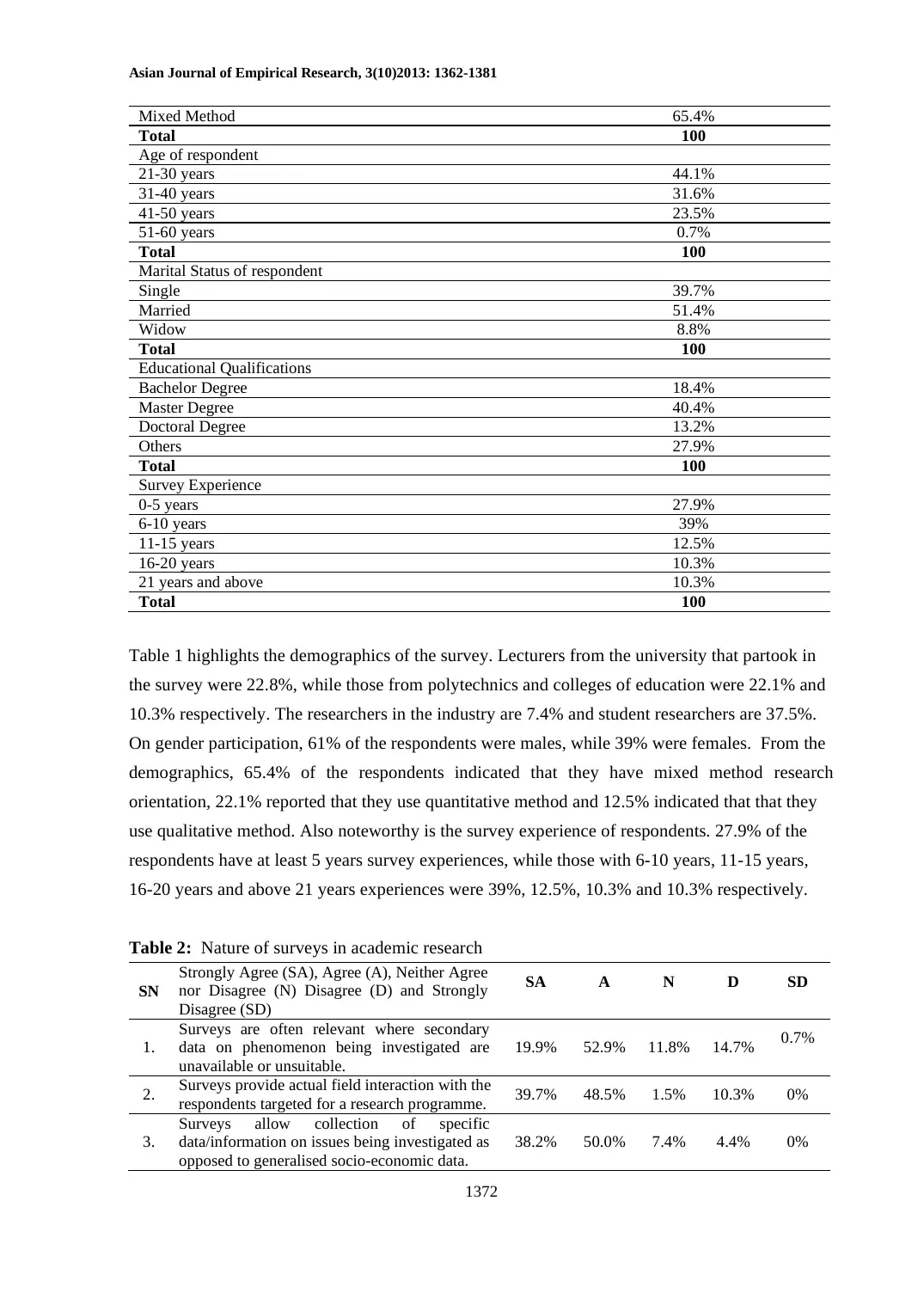
Asian Journal of Empirical Research, 3(10)2013: 1362-1381
1372
Mixed Method 65.4%
Total 100
Age of respondent
21-30 years 44.1%
31-40 years 31.6%
41-50 years 23.5%
51-60 years 0.7%
Total 100
Marital Status of respondent
Single 39.7%
Married 51.4%
Widow 8.8%
Total 100
Educational Qualifications
Bachelor Degree 18.4%
Master Degree 40.4%
Doctoral Degree 13.2%
Others 27.9%
Total 100
Survey Experience
0-5 years 27.9%
6-10 years 39%
11-15 years 12.5%
16-20 years 10.3%
21 years and above 10.3%
Total 100
Table 1 highlights the demographics of the survey. Lecturers from the university that partook in
the survey were 22.8%, while those from polytechnics and colleges of education were 22.1% and
10.3% respectively. The researchers in the industry are 7.4% and student researchers are 37.5%.
On gender participation, 61% of the respondents were males, while 39% were females. From the
demographics, 65.4% of the respondents indicated that they have mixed method research
orientation, 22.1% reported that they use quantitative method and 12.5% indicated that that they
use qualitative method. Also noteworthy is the survey experience of respondents. 27.9% of the
respondents have at least 5 years survey experiences, while those with 6-10 years, 11-15 years,
16-20 years and above 21 years experiences were 39%, 12.5%, 10.3% and 10.3% respectively.
Table 2: Nature of surveys in academic research
SN
Strongly Agree (SA), Agree (A), Neither Agree
nor Disagree (N) Disagree (D) and Strongly
Disagree (SD)
SA A N D SD
1.
Surveys are often relevant where secondary
data on phenomenon being investigated are
unavailable or unsuitable.
19.9% 52.9% 11.8% 14.7% 0.7%
2. Surveys provide actual field interaction with the
respondents targeted for a research programme. 39.7% 48.5% 1.5% 10.3% 0%
3.
Surveys allow collection of specific
data/information on issues being investigated as
opposed to generalised socio-economic data.
38.2% 50.0% 7.4% 4.4% 0%
1372
Mixed Method 65.4%
Total 100
Age of respondent
21-30 years 44.1%
31-40 years 31.6%
41-50 years 23.5%
51-60 years 0.7%
Total 100
Marital Status of respondent
Single 39.7%
Married 51.4%
Widow 8.8%
Total 100
Educational Qualifications
Bachelor Degree 18.4%
Master Degree 40.4%
Doctoral Degree 13.2%
Others 27.9%
Total 100
Survey Experience
0-5 years 27.9%
6-10 years 39%
11-15 years 12.5%
16-20 years 10.3%
21 years and above 10.3%
Total 100
Table 1 highlights the demographics of the survey. Lecturers from the university that partook in
the survey were 22.8%, while those from polytechnics and colleges of education were 22.1% and
10.3% respectively. The researchers in the industry are 7.4% and student researchers are 37.5%.
On gender participation, 61% of the respondents were males, while 39% were females. From the
demographics, 65.4% of the respondents indicated that they have mixed method research
orientation, 22.1% reported that they use quantitative method and 12.5% indicated that that they
use qualitative method. Also noteworthy is the survey experience of respondents. 27.9% of the
respondents have at least 5 years survey experiences, while those with 6-10 years, 11-15 years,
16-20 years and above 21 years experiences were 39%, 12.5%, 10.3% and 10.3% respectively.
Table 2: Nature of surveys in academic research
SN
Strongly Agree (SA), Agree (A), Neither Agree
nor Disagree (N) Disagree (D) and Strongly
Disagree (SD)
SA A N D SD
1.
Surveys are often relevant where secondary
data on phenomenon being investigated are
unavailable or unsuitable.
19.9% 52.9% 11.8% 14.7% 0.7%
2. Surveys provide actual field interaction with the
respondents targeted for a research programme. 39.7% 48.5% 1.5% 10.3% 0%
3.
Surveys allow collection of specific
data/information on issues being investigated as
opposed to generalised socio-economic data.
38.2% 50.0% 7.4% 4.4% 0%
⊘ This is a preview!⊘
Do you want full access?
Subscribe today to unlock all pages.

Trusted by 1+ million students worldwide
1 out of 21
Your All-in-One AI-Powered Toolkit for Academic Success.
+13062052269
info@desklib.com
Available 24*7 on WhatsApp / Email
![[object Object]](/_next/static/media/star-bottom.7253800d.svg)
Unlock your academic potential
Copyright © 2020–2025 A2Z Services. All Rights Reserved. Developed and managed by ZUCOL.
